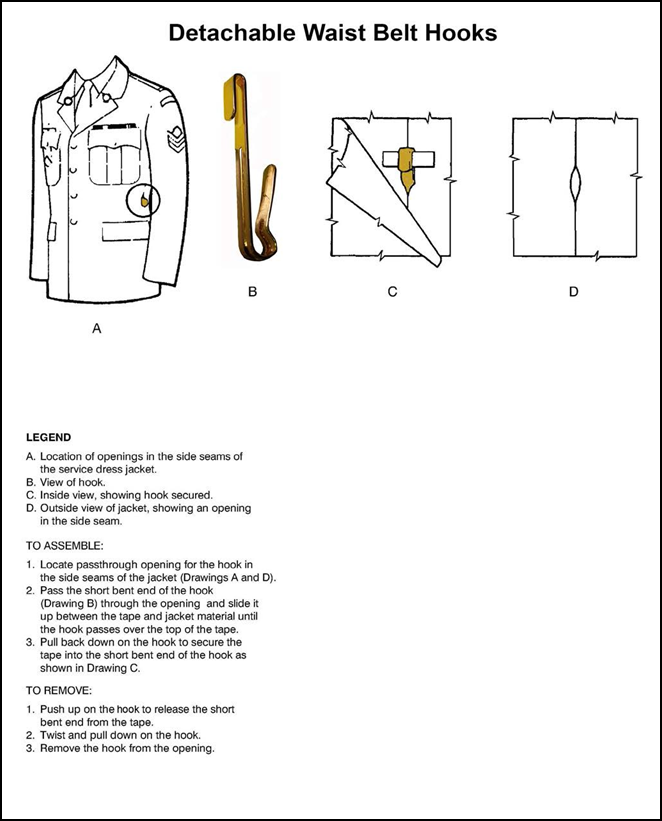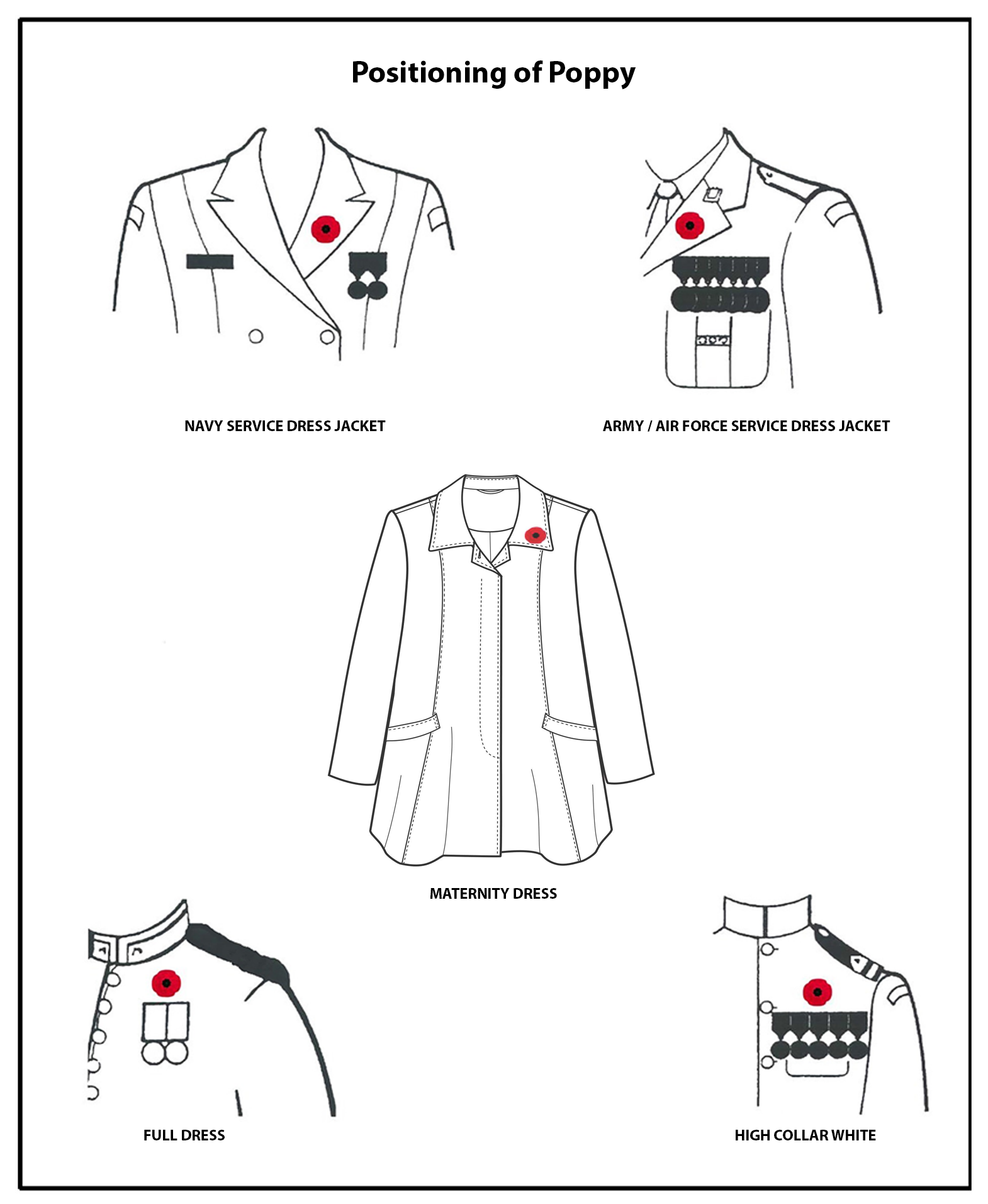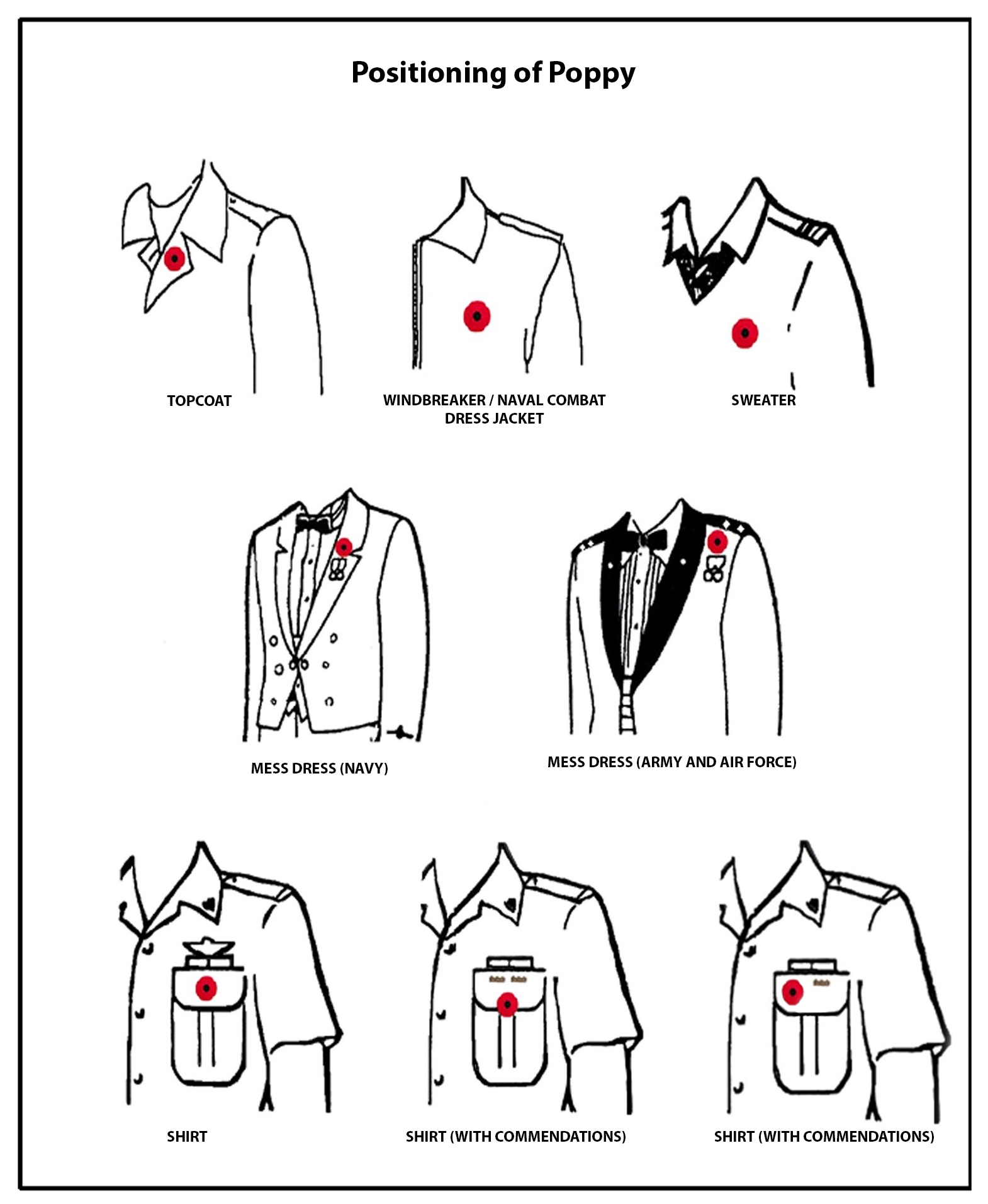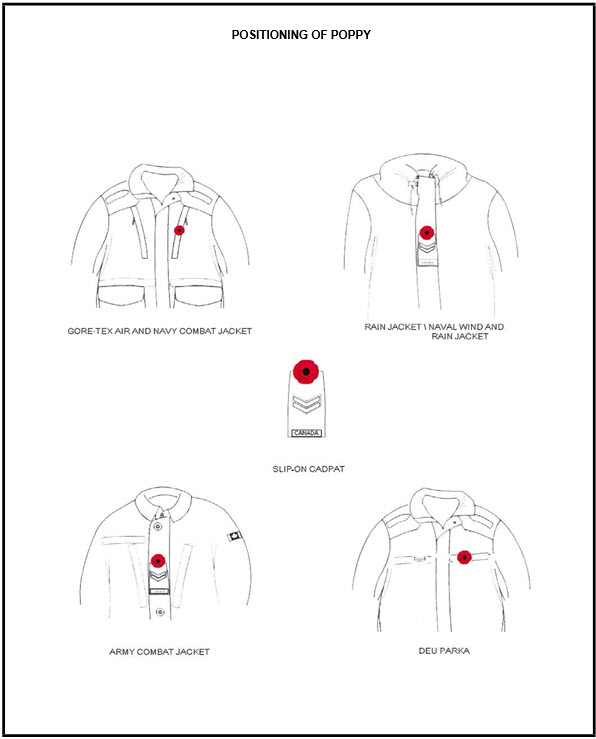Dress instructions | Section 7 Accoutrements
Table of contents
- SECTION 7 ACCOUTREMENTS (3-7-1)
- GENERAL (3-7-1)
- AIGUILLETTES (3-7-1)
- ROYAL CYPHERS AND PERSONAL BADGES (3-7-3)
- CEREMONIAL BELTS, SLINGS AND RELATED EQUIPMENT (3-7-5)
- SWORDS AND PISTOLS – CEREMONIAL OCCASIONS (3-7-5)
- SASHES (3-7-6)
- PACE STICKS AND CANES (3-7-6)
- MOURNING BANDS (3-7-7)
- NAME TAGS AND TAPES (3-7-7)
- REMEMBRANCE DAY AND COMMEMORATIVE SYMBOLS (3-7-7)
GENERAL
- The following items are authorized for wear with ceremonial and service dress uniforms:
- aiguillettes (see paragraphs 3. to 9.);
- Royal cyphers and personal badges (see paragraphs 10. to 18.);
- ceremonial belts, slings, and related equipment (see paragraphs 19. to 22.);
- swords and pistols (see paragraphs 23. to 27.);
- sashes (see paragraphs 28. to 31.);
- pace sticks and canes (see paragraphs 32. to 34.); and
- mourning bands (see paragraphs 35. to 39.).
- The following items are worn with various uniforms:
- name tags/tapes (see paragraphs 40. and 41.);
- symbols authorized for wear on Remembrance Day (see paragraphs 42-44.); and
- brassards.
AIGUILLETTES
- Aiguillettes may be worn in the CAF by:
- vice-regal personages on ceremonial, mess and service dress, based on the traditional dress of designated headquarters staff appointments; and
- all others to indicate an officer appointed to be in attendance on a designated dignitary or flag/general officer.
- The shoulder on which an aiguillette is worn indicates the appointment category as follows:
- right shoulder version – Royal and vice-regal personages and those holding personal appointments to these dignitaries. The aiguillette is always worn in conjunction with the Royal Cypher or personal badge;
- left shoulder version – Appointments to another military or civilian principal.
- The ceremonial aiguillette (gold metallic, standard two-tag design) shall be worn with ceremonial, service, and mess dress, by officers on the following occasions:
- ceremonial or formal occasions, when in attendance on the person to whom they are appointed, or when ordered to do so by appropriate authority;
- when attending a formal, official, or public function by reason of their appointment; and
- by CAF attachés/advisers and assistant attachés/advisers, in accordance with sub-paragraph 5.b.
- The duty pattern aiguillette (gold braided rayon cord, in a short shoulder loop with one suspended tag) is authorized for wear with No. 3 order of dress only, on occasions of a non-ceremonial or informal nature and during routine duties.
NOTE
Obsolete ceremonial and duty patterns braided with a coloured stripe matching the wearer’s winter DEU may be worn, until replaced, by members holding appointments to Lieutenant-Governors of provinces and military and civilian principals.
- Aiguillettes may be worn with short-sleeved orders of dress (both normal service dress and tropical tans), in hot climates in accordance with local protocol and international practice.
- Officers are authorized to wear aiguillettes when filling the following appointments:
| Principal | Appointment | Pattern to be Worn |
|---|---|---|
| Her Majesty The Queen and other members of the Royal Family |
|
Ceremonial right shoulder pattern. |
| Heads of Foreign States | Aide-de-Camp | |
| The Governor General |
|
|
| The Governor General as Commander-in-Chief | Chief of the Defence Staff | |
| Lieutenant-Governors of Provinces | Honorary Aide-de-Camp | |
| Head of Mission |
|
Ceremonial or duty patterns, left shoulder. |
| Minister of National Defence | Minister’s Staff Officer | |
Serving Officers of the CAF in the rank of, or equivalent to:
|
|
Ceremonial or duty patterns, left shoulder. |
| Serving Officers of the CAF in the rank of Brigadier-General or equivalent, other than those listed previously | Officers appointed as Personal Assistants to a Principal, during official visits or inspections by:
|
Ceremonial or duty patterns, left shoulder. |
| Ministers of the Crown |
|
|
| Visiting military or civilian officials |
|
|
| Dignitaries of other countries |
|
- Illustrations and instructions for the wear of aiguillettes are in Annex G.
ROYAL CYPHERS AND PERSONAL BADGES
- Cyphers and badges shall be worn on all appropriate orders of dress, less occupational dress, by those officers holding personal appointments to the principals listed below and with the exception of operational dress, always worn with the aiguillette. Cyphers and personal badges are of gilt metal when worn with orders of dress 1, 2, or 3. Embroidered cyphers and badges are worn as an exception with operational clothing. The distinguishing cyphers and badges shall not be worn by CAF members after they cease to hold the personal appointments.
- Her Majesty The Queen. The shoulder device is a Royal Cypher surmounted by the Crown, both of gilt metal. Two sizes of the Royal Cypher have been approved as follows:
- a large Cypher, 3.1 cm high and 3.1 cm wide, including a fixed Crown, for wear with ceremonial and service dress uniforms, topcoats (gabardines) and rain-coats; and
- a small Cypher, 2.4 cm high and 2.4 cm wide, including a fixed Crown, for wear with mess dress.
- His Royal Highness The Duke of Edinburgh. The shoulder device is HRH Prince Philip’s cypher (two scripted letters “P” back to back) surmounted by a ducal coronet. The cypher is 2.5 cm high and 2.5 cm wide and the coronet 0.6 cm high and 1.2 cm wide. The cypher is of gilt or silver and is authorized for wear with ceremonial, service and mess dress uniforms, as well as on corresponding outerwear.
- His Royal Highness The Prince of Wales. The shoulder device is the bronze coloured badge of the heir apparent. The badge exists in only one size for wear with ceremonial, service and mess dress uniforms, as well as on corresponding outerwear.
- Other Members of the Royal Family. If an officer is appointed to serve any other member of the Royal Family, advice should be sought from NDHQ/DHH to determine which badge or cypher, if any, should be worn. See also paragraph 16.
- Vice Regal Principals
- The Governor General. The shoulder device for the Aides-de-Camp to the Governor General is the badge of the Governor General, which is the Crest of the Arms of Canada, in gold coloured (gilt) metal. The device has left and right shoulder patterns (the lions to face forward), its dimensions being 30 mm square, and is worn at the base of the shoulder strap on the service dress jacket. See also paragraph 18., and for comparison, the details of appointment insignia for the Governor General as Commander- in-Chief in Section 2, paragraph 1.
- Lieutenant-Governors. The shoulder device for the Honorary Aides-de- Camp to a Lieutenant-Governor is the shield of the Provincial Arms surmounted by the Crown, normally produced in metal. For method of wear, see paragraph 17.
- Acquisition. The approved cyphers and badges are not a service issue. They are obtained from the Royal or vice-regal household. Officers appointed to serve Royal or vice-royal personages may correspond directly with the appropriate military or private secretary on these matters. If required, advice on addresses can be obtained from NDHQ/DHH. Commercial suppliers may also be able to provide cyphers, however, this could be both expensive and result in an incorrect design. The Royal’s personal staff normally ensure quality control.
- Method of Wear
- Officers below flag/general officer rank shall wear cloth shoulder-straps on ceremonial, service and mess dress jackets, on which the cyphers and badges are authorized to be worn. On jackets which are not normally equipped with shoulder-straps, plain shoulder-straps of the pattern worn by general officers, less badges of rank, shall be felled onto both shoulders, at the shoulder seams, and shall be fastened at the collar ends by means of 26-ligne buttons. Cyphers and badges shall then be centred on both straps, 2 cm above the shoulder seam or just above a metal shoulder title. When worn on the shoulder straps of officers of flag/general rank, cyphers and badges shall be placed at the bottom of the strap, below the lowest maple leaf, evenly and centrally displayed, with the bottom of the cypher or badge being even with the bottom edge of the strap.
- When worn on the shoulder-straps/boards of army Nos. 2 and 2A mess orders of dress, and on slip-ons worn on the shoulder-straps of navy, army and air force topcoats (gabardines), raincoats and short-sleeved shirts, the bottom edge of the cypher or badge shall be centred and even with the lower edge of the lowest row of rank braid. If difficulties are encountered in fitting the cypher on the shoulder strap/board obtained from the household or commercial supplier, the matter may be referred to NDHQ/DHH for tailoring assistance.
- When worn on gold plaited shoulder cords, cyphers and badges shall be evenly and centrally displayed with the bottom of the cypher or badge as close to the bottom edge of the shoulder cord as possible.
- Shoulder boards – Household Appointments to the Governor General
- Shoulder boards and straps, worn in the manner described in paragraph 17., are approved for wear with the following orders of dress:
- No. 1, 1A and No. 2 orders – shoulder boards of appropriately coloured shell material, with the Vice-Regal Badge in gold embroidery;
- No. 1B, 1C, 1D, No. 2 (Army) and No. 2A orders – shoulder straps/ boards of appropriately coloured shell material, with the Vice-Regal Badge in gilt metal; and
- No. 3 order – (Navy and Air Force) – shoulder straps of appropriately coloured shell material, with the Vice-Regal Badge in gilt metal.
- Provision shall be as arranged by Government House.
- The embroidered badges shall be worn only by Regular Force officers holding household appointments to the Governor General.
- Shoulder boards and straps, worn in the manner described in paragraph 17., are approved for wear with the following orders of dress:
CEREMONIAL BELTS, SLINGS AND RELATED EQUIPMENT
- CAF patterns of white ceremonial belts, rifle slings, pistol holsters and bayonet carriers are authorized for wear with ceremonial orders of dress, including over topcoats (gabardines), as appropriate.
- Detachable waist belt hooks are provided to support the CAF pattern white belt, when worn with service dress jackets (see Figure 3-7-1).
- A universal-pattern gold-plated, stamped brass buckle, displaying the CAF badge, is provided for wear with the white ceremonial belt. Units may wear an approved branch/regimental pattern brass buckle as an optional item in lieu.
- Rifle and Armour regiments may wear black accoutrements as optional items instead of white.
SWORDS AND PISTOLS – CEREMONIAL OCCASIONS
- Officers, chief petty officers first class (CPO1) and chief warrant officers (CWOs) wear swords or pistols with ceremonial orders of dress, No. 1, 1B and 1C. Non- commissioned members other than CPO1s and CWOs may also be ordered to wear swords or pistols when unit custom so dictates.
- THE FOLLOWING SWORDS ARE PROVIDED FOR USE AS REQUIRED:
- Navy officer pattern, gold and navy blue sword knot, with black sword belt and slings, for use by Navy officers, including flag officers and CPO 1;
- universal pattern (infantry), for use by Army members and other Navy NCMs;
- air force pattern, gold and light blue sword knot, with white sword belt and slings, for use by Air Force personnel, including general officers, and CWOs; and
- flag/general officer’s scimitar, for use by the Chief of the Defence Staff.
- Approved branch/regimental patterns of swords may be worn as optional items by army members. Sword belts, slings and knots shall be the CAF standard pattern or an approved regimental pattern as an optional item. The belt shall be fastened by a waist buckle displaying either the CAF or, as an optional item, a branch or regimental device.
- CAF standard pattern sword belts are equipped with slings, metal furnishings and a hook to suspend the scabbard when worn outside of the jacket. The belt is held in position on army and air force jackets by removable metal waist belt hooks inserted into two slots, which are located at the waist line on the jacket side seams (see Figure 3-7-1). The sword belt is worn under the navy jacket at all times, and may be worn under the army jacket or full dress great coat by branches/regiments, in accordance with branch/regimental customs.
- Pistols shall be worn on the left side.
SASHES
- These accoutrements indicate rank and authority.
- Officer and CWO Rank Sashes
- Approved officer rank sashes (worn also by CWOs) are authorized for wear with Royal Military College of Canada (RMCC), infantry, and Air Force full dress (No. 1B), and all army undress, (optional No.1C and 1D – authorized for wear by RMCC officer cadets and the Army Reserve only) where cross belts are not worn.
- Officers and CWOs shall wear waist sashes fastened on the left hip, except those in kilted units, who wear sashes over the left shoulder falling off the right hip.
- Princess Patricia’s Canadian Light Infantry officers and CWOs and those in kilted units may wear sashes while carrying swords with No. 1 order of dress.
- Warrant Officer and Sergeant Rank Sashes
- Approved warrant officer and sergeant shoulder rank sashes are authorized for wear with RMCC, infantry, and air force (see sub- paragraph 31.b.) ceremonial orders of dress at all times, and with No. 2B mess service dress and No. 3 service orders while on unit duty in accordance with environmental and regimental policy.
- The shoulder sash is worn from the right shoulder falling off the left hip, unless worn in conjunction with a Scottish broad sword shoulder belt, when it is worn from the left shoulder falling to the right. Sashes are worn over trouser and waist belts, over greatcoats and topcoats (gabardines) when a waist belt is also worn overall as a ceremonial accoutrement.
- Sash Colours
- RMCC and army sashes are crimson or scarlet, depending on the rank group, except as noted:
- the RMCC cadet wing commander wears a crimson sash with gold tassels;
- foot guard officers wear a crimson and gold sash on state occasions; and
- officers of Les Fusiliers Mont-Royal wear a “fléchée” sash.
- Air force sashes are deep maroon and only worn by pipe band members.
PACE STICKS AND CANES
- Canes may be carried routinely and during ceremonial activities by senior disciplinarians CPO1 and CWOs at Royal Military College of Canada Training schools, Brigade, Base, Divisional Support Groups and units where canes are customarily carried.
NOTE
Canes are not customarily carried by navy or air force personnel.
- Pace sticks are an “aid to drill” and may be carried by WOs and NCOs during the conduct of, evaluation of, and in preparation for drill lessons, practices.
- Personnel holding equivalent appointments in other commands may carry canes with the approval of the commander of the command.
MOURNING BANDS
- A mourning band is an adjustable black crepe band, 9 cm wide, worn on ceremonial and service dress jackets and on the topcoat (gabardine) and raincoat, midway between the elbow and shoulder on the left sleeve. The wearer is thus seen to “wear mourning”; court, service, or private. See QR&O 17.15, 17.16 and 17.17.
- Mourning bands shall be worn on the uniform by:
- officers on specified duty when the court is in mourning (see QR&O 17.15);
- officers when service mourning is directed (see QR&O 17.16); and
- officers, CPO1s and CWOs participating in a military funeral or memorial service (see QR&O 17.17).
- Mourning bands may be worn by officers or non-commissioned members at a private funeral in the event of personal bereavement.
- Mourning bands shall not be worn at the unveiling of memorials, Remembrance Day services, or similar ceremonies.
- Mourning bands shall be removed immediately upon leaving the place of interment or memorial service, unless worn in accordance with instructions for court or service mourning.
NAME TAGS AND TAPES
- Name Tags
- Standard CAF name tags shall be detachable, made of black and white (for navy and army personnel) or air force blue and white (for air force personnel) laminated plastic plate 6.3 cm in length and 1.2 cm in height, inscribed with white lettering 0.6 cm high, and shall indicate the surname of the member only. They shall be acquired through the CAF Supply System.
- Name tags shall be worn with ceremonial (other than full dress and army undress), service, and occupational orders of dress as detailed in Annex G, and Chapter 7.
- Personnel on the staff of, or assigned for duty to Integrated Headquarters (e.g., SHAPE, SACLANT and NORAD), shall wear name tags as detailed by the commander concerned.
- Name Tapes. Two styles are authorized. Both are acquired through the supply system. Both are worn as detailed in Annex G.
- Type A – C ADPAT. In Enhanced Visibility or environmental subdued colours: 1 cm high embroidered letters on a 2.5 cm high tape. Tactical flight suit description: 1 cm high embroidered letters on a 5.1 cm high tape. Surname and environmental identifier (navy, fouled anchor; army, crossed swords; air force, eagle) only.
- Type B – Environmental Colours. Worn on all other clothing requiring a name tape: occupational clothing, naval combat dress and flying clothing. Description: 1.0 cm high embroidered letters on a 2.5 cm high tape available in the three environmental uniform colours. Surname and element only, except for Medical Technicians while employed in a hospital whereas the rank is also displayed on the nametape.
REMEMBRANCE DAY AND COMMEMORATIVE SYMBOLS
- Poppies
- The Royal Canadian Legion approved Poppies are authorized to be worn. The red poppy is an emblem of the RCL and is used to commemorate Canadians who died in battle. CAF members shall wear the poppy on all uniforms from the last Friday in October until Remembrance Day (November 11th) and are encouraged to wear it when attending any event whose main purpose is to commemorate Canadians who died in battle. Positioning of the poppy is illustrated in Figure 3-7-2 thru Figure 3-7-4.
- Indigenous crafted poppies. To recognize and honour the contributions of First Nations, Inuit and Métis peoples while adhering to established guidelines for Remembrance Day observance, the Indigenous crafted poppies are also authorized for wear on CAF Uniforms. They shall be worn in the same manner as the RCL Poppies. They must meet the following criteria:
- not less than 3.8 cm and no greater than 5.1 cm in diameter;
- poppies shall be red with black accents; and
- Poppy material is not limited to solely beads, the poppy may be made from other materials including, but not limited to, seal skin, porcupine quill, and caribou bone and other culturally significant materials.
- The Forget-Me-Nots. The wearing of the Forget-Me-Not flower is authorized for members of The Royal Newfoundland Regiment and their military guests for any event held on or around 1 July of each year, to commemorate the action at Beaumont-Hamel. Positioning of the Forget-Me-Nots is as the positioning of the poppy.
- UN Blue Beret/MFO Orange Beret. The wear of the UN or the MFO beret is authorized for CAF personnel who have served on a UN or MFO mission only on the National Peacekeeping Day and by individuals currently serving on a UN or a MFO mission. The National Peacekeeping Day is the 9th of August.
- Authority to wear these force identifiers on other occasions must be requested from the international organization concerned via NDHQ/DHH through the chain of command. As much warning time as possible should be given since international military staff are slow to respond to such special-request administrative matters. Units tasked to provide guards or vigils are to turn out appropriate numbers of personnel wearing normal uniforms and with current weapons and equipment, as for any military task. The task is for a guard and/or vigil party, not re-enactment of one type of past peacekeeping duty.
- Eligible personnel who wish to wear this headdress and require a replacement UN beret may purchase one at no cost to the public by submitting a formal request to the nearest supply section

Figure 3-7-1 Detachable Waist Belt Hooks

Figure 3-7-2 Positioning of the Poppy

Figure 3-7-3 Positioning of the Poppy

Figure 3-7-4 Positioning of the Poppy